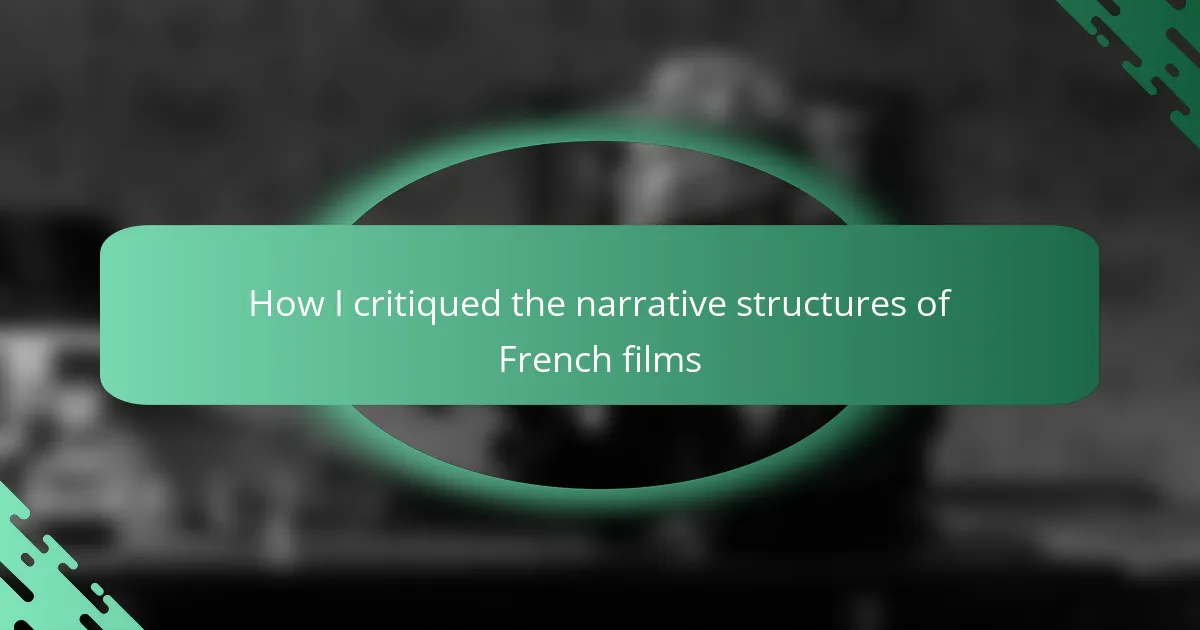Key takeaways
- French film narratives prioritize character development and emotional landscapes over traditional plot structures, inviting deeper personal engagement.
- Common techniques include non-linear timelines, symbolism, and open endings, which provoke introspection and discussions beyond the film’s conclusion.
- The emphasis on realism and mundane experiences adds authenticity, making the emotions resonate with viewers’ own lives.
- Critiques often assess character evolution, thematic depth, pacing, and cinematography, highlighting how these elements contribute to the overall narrative experience.
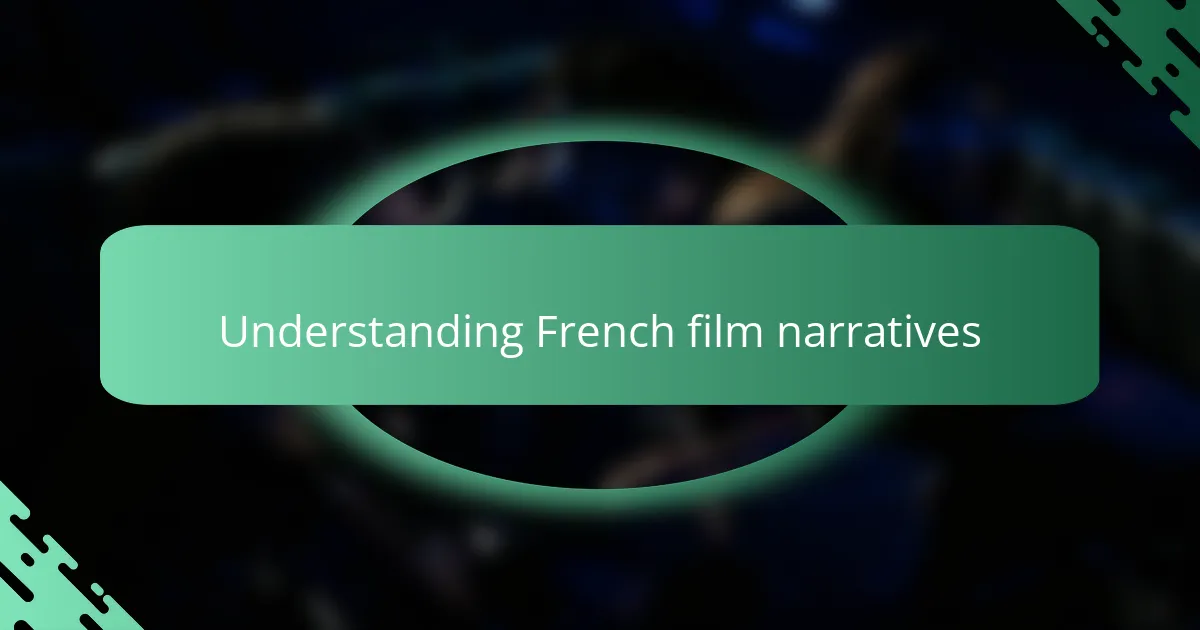
Understanding French film narratives
French film narratives often deviate from traditional storytelling patterns, embracing a more fluid and introspective approach. I remember watching a classic like “À bout de souffle” and feeling as if the film was less about the plot and more about the characters’ emotional landscapes. This approach invites viewers to engage with the story on a deeper, more personal level.
In my experience, the use of non-linear timelines in French cinema can initially be disorienting but ultimately enriches the viewing. For instance, I found myself captivated by how “La Haine” weaves its narrative through different perspectives, allowing me to reflect on the social issues at play. It made me wonder, how often do we get such layered perspectives in mainstream films?
French films often prioritize mood and atmosphere over conventional resolutions. I’ve felt a profound connection to films that leave questions unanswered, echoing the complexities of real life. Why do we seek closure in every story when uncertainty can lead to more profound reflections? In my journey through French cinema, I’ve come to appreciate that these open-ended narratives challenge us to think and feel in ways that resonate much longer after the credits roll.
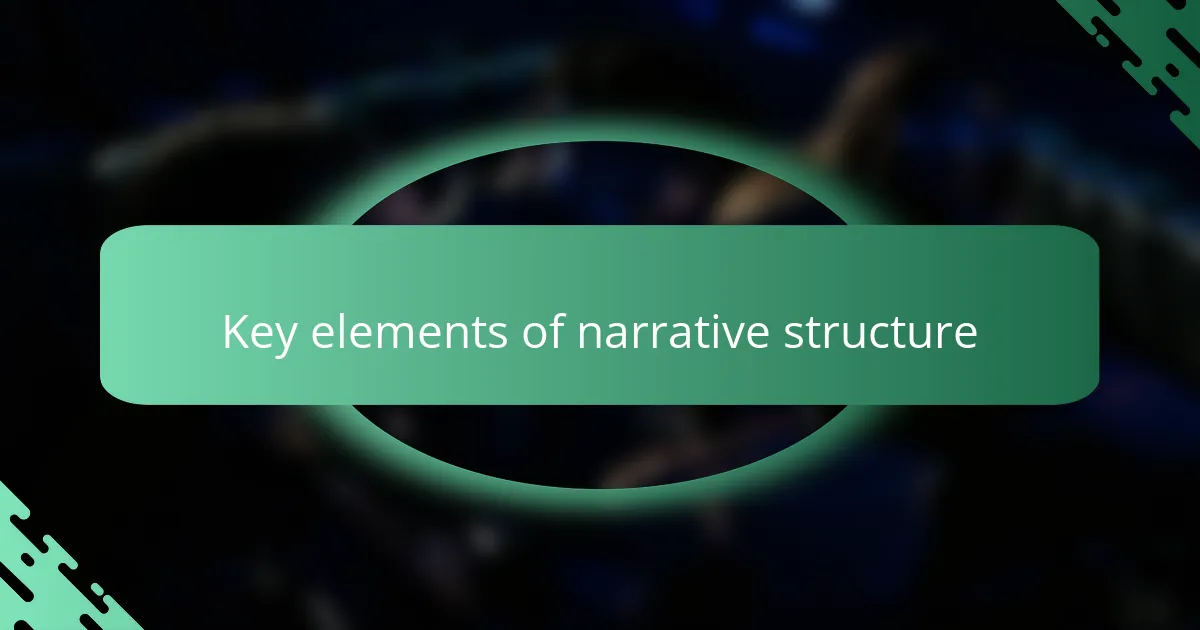
Key elements of narrative structure
Narrative structure in French films often hinges on character development, where the intricacies of each persona take center stage. I remember watching “The Diving Bell and the Butterfly” and being profoundly moved by how the narrative was wrapped around the protagonist’s inner journey. It made me realize that in many French films, the transformation of characters often outweighs the importance of a conventional plot, inviting deeper emotional connections.
Another key element I’ve noticed is the reliance on symbolism and subtext. Films like “Blue Is the Warmest Color” beautifully layer meaning beneath visual and emotional experiences. This makes me question, how often do we miss these subtle cues in other cinema? Engaging with these elements can significantly enhance our understanding of the narrative and the themes behind it.
Lastly, the use of realism in dialogue stands out as a hallmark of French storytelling. When characters speak their truths imperfectly, as they do in “Amélie,” it creates an authentic rapport with the audience. In my view, this mundane honesty fosters a genuine connection, reminding us that life’s beauty often lies in its imperfections. Isn’t it refreshing to witness stories that resonate so strikingly with our own experiences?
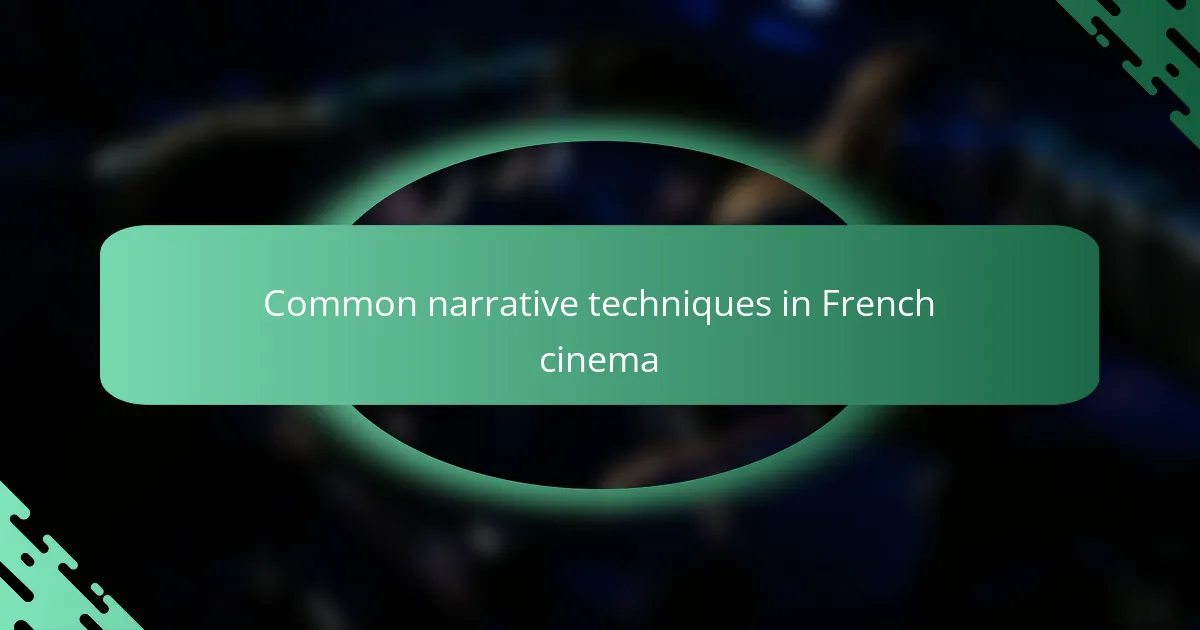
Common narrative techniques in French cinema
In exploring common narrative techniques in French cinema, I’ve consistently noticed the emphasis on fragmentation as a storytelling device. Films like “Eternal Sunshine of the Spotless Mind” (though technically American, its influence is palpable in French cinema) skillfully present disjointed timelines, leaving viewers piecing together the emotional puzzle of the characters’ journeys. This approach can be perplexing but, in my experience, also deeply rewarding as it mirrors the way we often remember our own lives—full of fragmented moments that reveal our true selves.
Another technique that fascinates me is the interplay between the mundane and the profound. Take “The 400 Blows,” for instance, where the seemingly trivial moments of adolescence resonate with deeper themes of alienation and rebellion. I can’t help but reflect on how often we overlook the extraordinary within the ordinary. French films excel at magnifying these subtle contrasts, urging us to find meaning in everyday experiences.
Then there’s the innovative use of open endings. I remember the sensation I felt after watching “La Haine,” where the narrative closes without tidy resolutions. This defiance of closure invites discussions about morality and the weight of choices, echoing the complexities of societal challenges. Isn’t it intriguing how such narratives compel us to leave the theater with more questions than answers, fostering a dialogue long after the film has ended?
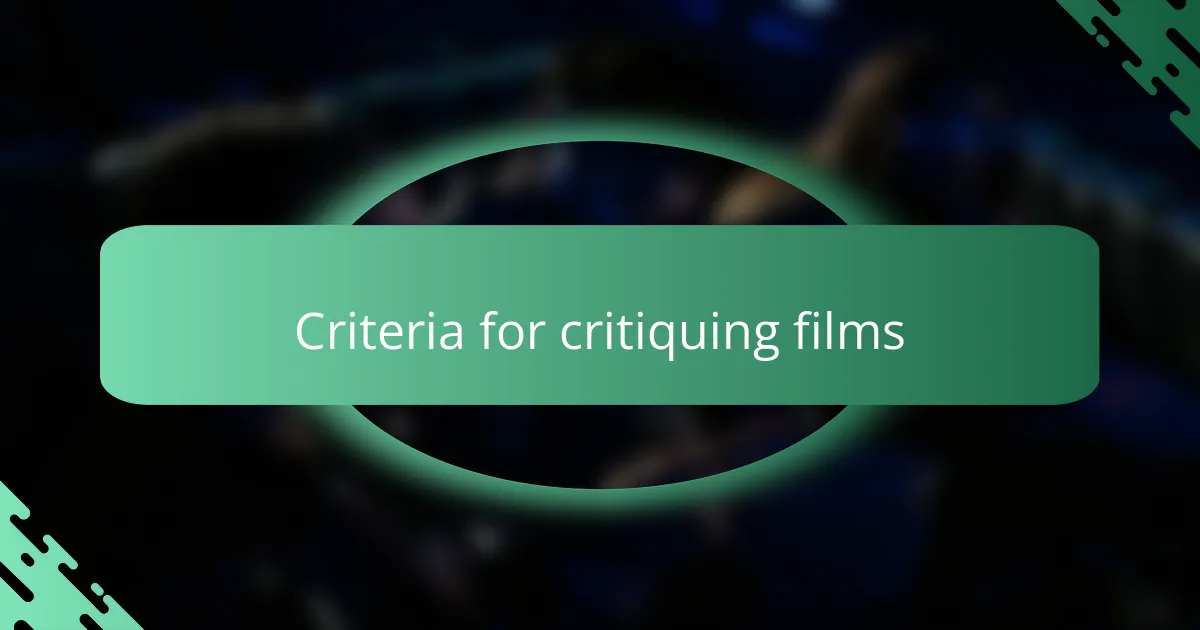
Criteria for critiquing films
When critiquing narrative structures in French films, I focus on several key criteria, such as character development, plot cohesion, and thematic depth. Each film often reflects unique cultural nuances and storytelling techniques, which can evoke strong emotional responses. For me, exploring how these elements interconnect offers a rich experience—something I cherish while watching.
Another important aspect is pacing and how it aligns with the story’s emotional arcs. I’ve noticed that some films take a more leisurely approach, allowing viewers to fully immerse themselves in the characters’ journeys, while others might rush through pivotal moments. This difference can significantly impact how we perceive a film’s narrative.
In my experience, the cinematography often tells a story of its own, enhancing or detracting from the narrative. I remember being captivated by the use of color in La La Land, which, although American, shares similarities with the emotional and aesthetic choices seen in French cinema. It’s fascinating how the visual storytelling complements the written narrative.
“`html
| Criterion | Description |
|---|---|
| Character Development | How well characters evolve throughout the story. |
| Plot Cohesion | The logical flow and connection between events. |
| Thematic Depth | Exploration of underlying messages and ideas. |
| Pacing | The rhythm of storytelling; how tension and release are managed. |
| Cinematography | The visual composition and its contribution to the narrative. |
“`

Personal experience with French films
There’s something uniquely captivating about diving into French films. I remember the first time I watched “Amélie.” The whimsical storytelling and vivid cinematography pulled me right into Parisian life. It was an experience that made me smile, but it also got me thinking—why did this film resonate so deeply with me while others didn’t?
As I explored more, I noticed that each film offers a different lens through which to view the world. Watching “The Intouchables” was particularly enlightening; it tackled themes of friendship and resilience with such grace. I found myself laughing and crying simultaneously, contemplating the beauty of human connections. Isn’t it powerful how a film can spark such a range of emotions?
Reflecting on these experiences, I’ve realized that French films often provoke introspection. After seeing “La La Land,” I couldn’t help but draw parallels with the emotional authenticity often found in French cinema. It left me pondering the choices we make in pursuit of our dreams and relationships. I wonder, how often do we give ourselves the space to reflect on our own stories in such a meaningful way?

Insights from recent reviews
When I delve into recent reviews of French films, I often find myself captivated by their unique narrative structures. For instance, in a recent viewing of “Portrait of a Lady on Fire,” I was struck by how the film carefully avoided traditional storytelling techniques. The slow unraveling of the relationship between the protagonists created an intimate atmosphere that resonated deeply with me, evoking a blend of nostalgia and yearning.
In contrast, films like “Les Misérables” challenged my expectations with their rapid pacing and intertwining storylines that reflect contemporary societal issues. I vividly remember feeling the tension build as the film progressed, a true testament to how effectively the narrative structure can manipulate viewer emotions. These experiences have enriched my understanding of the artistry present in French cinema.
- Emphasis on character-driven stories rather than plot-centric narratives.
- Use of vivid imagery and a focus on sensory experiences to engage viewers.
- Non-linear storytelling that encourages viewers to piece together the narrative.
- Social commentary woven seamlessly into personal stories.
- Subversion of conventional climaxes to foster a more reflective viewing experience.
